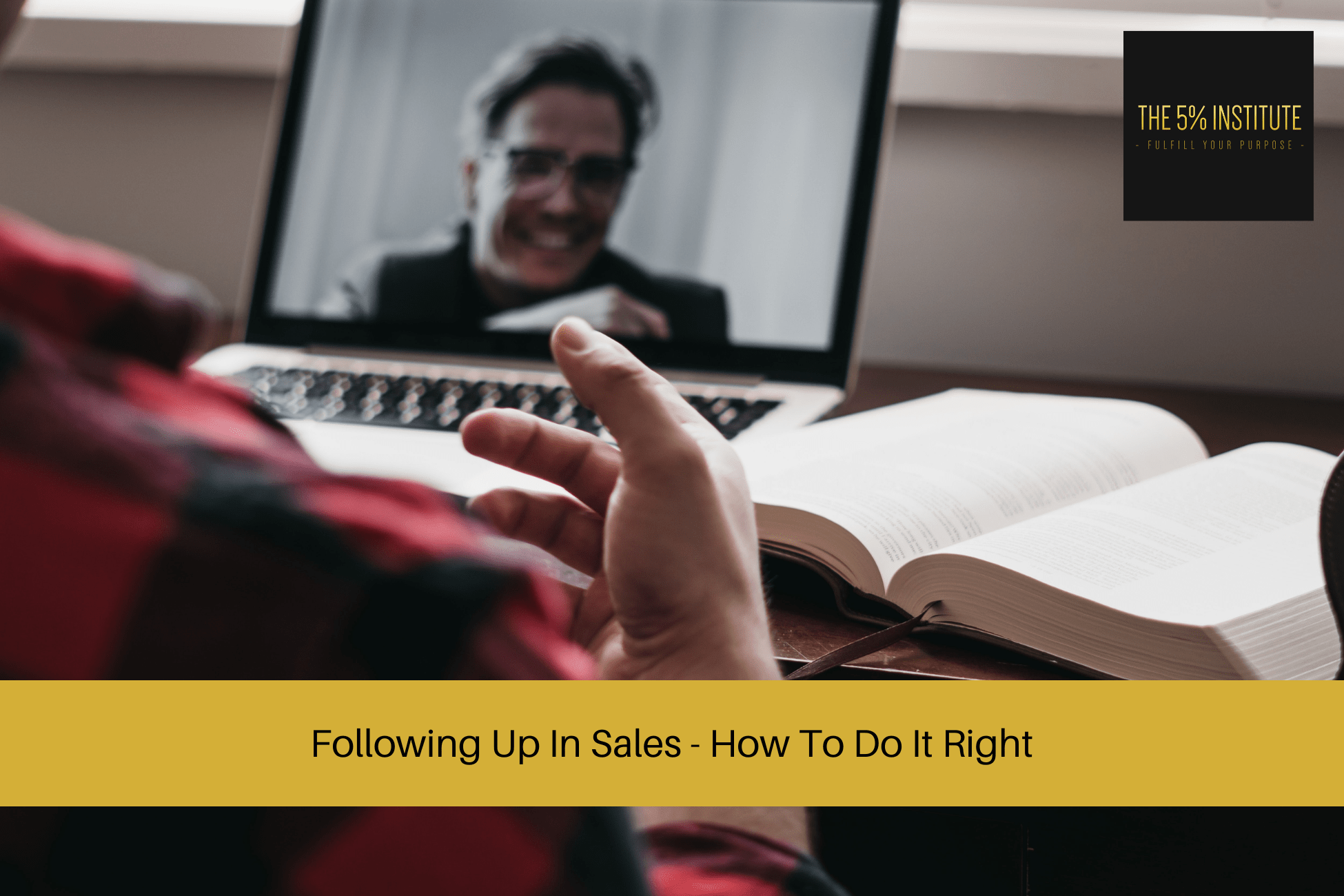
Following Up In Sales – How To Do It Right
In the fast-paced world of sales, following up with potential customers is an indispensable practice that can significantly impact your success. Effective follow-up strategies allow you to nurture relationships, address concerns, and ultimately close deals.
By mastering the art of following up, you can establish strong connections, build trust, and maximize your sales opportunities.
In this comprehensive guide, we will explore the importance of following up in sales and provide practical tips to help you become a master of effective communication.
So let’s dive in and unlock the secrets of successful follow-up!
The Importance of Following Up in Sales
Following up in sales is not just a courtesy; it is a strategic move that can yield remarkable results.
When you follow up with potential customers, you demonstrate your commitment and professionalism.
It shows that you value their time and are genuinely interested in helping them find the right solution.
Moreover, following up allows you to build rapport and trust, as it gives you an opportunity to address any concerns or objections they may have.
By maintaining consistent communication, you stay top-of-mind and increase the chances of closing a sale.
Remember, in sales, persistence pays off!
Planning Your Follow-up Strategy
To ensure your follow-up efforts are effective, it is essential to have a well-defined strategy in place.
Here are some key steps to consider:
Setting Clear Objectives
Before initiating any follow-up activities, clarify your objectives.
Ask yourself what specific outcomes you want to achieve. Are you aiming to schedule a product demo, secure a meeting, or close a deal?
Setting clear objectives will help you tailor your communication and stay focused on your goals.
Each follow-up should align with the desired outcome you have set.
Choosing the Right Communication Channels
Selecting the appropriate communication channels is crucial for successful follow-up.
Consider your target audience and their preferences.
Some people may prefer email, while others may respond better to phone calls or even social media messages.
Understanding your customers’ preferred channels will enhance your chances of engaging with them effectively.
By meeting them where they are most comfortable, you can establish better connections and foster meaningful conversations.
Establishing a Timeline
Timing is everything in sales.
Establishing a follow-up timeline that strikes the right balance between staying engaged and avoiding being overly pushy is crucial.
Depending on the context, a follow-up within 24 to 48 hours after an initial interaction is generally recommended.
However, adapt your timeline based on the nature of the sale and the customer’s responsiveness.
Remember to maintain consistency without becoming intrusive.
Crafting Effective Follow-up Messages
Crafting compelling follow-up messages is an art form that can significantly influence the outcome of your sales efforts.
Here are some tips to consider when creating impactful follow-up messages:
Personalization and Customization
Tailor your messages to each individual recipient.
Reference previous conversations or specific pain points they mentioned.
Personalization demonstrates your attention to detail and genuine interest in their needs.
By making your follow-up messages personal, you create a connection that resonates with the recipient, making them more likely to engage and respond positively.
Clear and Concise Communication
In today’s fast-paced world, attention spans are short, and time is precious.
Get straight to the point and clearly articulate your message.
Avoid lengthy emails or convoluted explanations.
Busy prospects appreciate concise communication that delivers value without wasting their time.
By presenting information in a clear and concise manner, you make it easier for potential customers to understand your message and take the desired action.
Adding Value to the Conversation
Ensure that each follow-up message provides something of value to the recipient.
Share relevant industry insights, useful resources, or exclusive offers that can help them in their decision-making process.
Adding value positions you as a trusted advisor rather than a pushy salesperson.
When recipients perceive the value you bring to the table, they are more likely to engage and consider your offerings.
Leveraging Automation and Technology
In today’s digital age, leveraging automation and technology can significantly enhance your follow-up efforts.
Here are some tools and strategies to consider:
CRM Systems
Customer Relationship Management (CRM) systems allow you to track and manage interactions with potential customers effectively.
They provide a centralized database for storing contact information, tracking communication history, and scheduling follow-up activities.
A CRM system ensures that no lead falls through the cracks and helps you maintain a comprehensive overview of your sales pipeline.
Email Sequences
Email sequences automate (like ActiveCampaign) the follow-up process by sending a series of pre-scheduled emails to potential customers.
This approach enables consistent and timely communication while allowing you to tailor messages based on the recipient’s engagement and responses.
With email sequences, you can set up a sequence of follow-up messages that gradually build rapport, deliver valuable content, and guide prospects through the sales funnel.
Sales Engagement Tools
Sales engagement tools help streamline and optimize your follow-up activities.
These tools offer features like email tracking, call recording, and analytics to measure the effectiveness of your outreach.
By leveraging data-driven insights, you can refine your follow-up strategy and focus on the most promising leads.
Sales engagement tools empower you to monitor customer interactions, gain insights into their engagement levels, and make informed decisions to enhance your follow-up efforts.
Overcoming Objections and Addressing Concerns
During the follow-up process, you are likely to encounter objections and concerns from potential customers.
Here’s how you can handle them effectively:
Active Listening
When faced with objections, practice active listening.
Give your undivided attention, show empathy, and seek to understand the underlying concerns fully.
Active listening allows you to address objections effectively and provide relevant solutions.
Repeat the objection to ensure you’ve captured it correctly and respond with information that specifically alleviates their doubts.
Providing Solutions and Benefits
Instead of focusing solely on the features of your product or service, highlight the benefits and solutions it offers.
Explain how it solves the customer’s pain points and adds value to their business.
By focusing on solutions, you can overcome objections and position yourself as a problem solver.
Presenting the tangible benefits of your offering reinforces its value and helps potential customers see how it aligns with their needs and goals.
Building Trust and Rapport
Establishing trust and rapport is crucial in the follow-up process.
Be genuine, transparent, and responsive.
Provide testimonials, case studies, or references from satisfied customers to instil confidence in your offering.
Building trust creates a solid foundation for successful sales relationships.
When customers trust you and believe in your expertise, they are more likely to engage with you, share their concerns openly, and consider your recommendations.
The Power of Persistence
Persistence is key when it comes to following up in sales.
It’s important to remember that not every prospect will respond positively or immediately.
Don’t be discouraged by initial non-responses or rejections.
Stay committed to your follow-up strategy, adapt as necessary, and continue to nurture relationships.
Timing is often critical, and a well-timed follow-up can lead to a breakthrough. Remember, a “no” today doesn’t mean a “no” forever.
By persistently staying engaged and demonstrating value, you increase the chances of converting potential customers into satisfied clients.
How To Follow Up In Sales – Conclusion
Following up in sales is an essential practice that can significantly impact your success.
By planning a well-defined follow-up strategy, crafting personalized and valuable messages, leveraging automation and technology, overcoming objections with empathy, and staying persistent, you can enhance your sales process and increase your chances of closing deals.
So embrace the power of following up and unlock the full potential of your sales efforts.
Sales Follow Up Frequently Asked Questions
Why is following up important in sales?
Following up is crucial in sales as it demonstrates commitment, builds rapport, addresses concerns, and increases the chances of closing deals.
It shows potential customers that you value their time and are genuinely interested in helping them find the right solution.
By maintaining consistent communication, you stay top-of-mind and create opportunities for further engagement.
How often should I follow up with a potential customer?
The frequency of follow-up depends on the context and the customer’s responsiveness.
Generally, a follow-up within 24 to 48 hours after an initial interaction is recommended.
However, adapt your timeline based on the nature of the sale and the customer’s preferences.
Strive for a balance between staying engaged and respectful of their time.
What are some best practices for crafting follow-up messages?
Some best practices for crafting follow-up messages include personalizing and customizing each message, communicating concisely, and adding value to the conversation.
Tailor your messages to individual recipients, get straight to the point, and provide valuable insights or resources that help them in their decision-making process.
By making your messages relevant and valuable, you increase the chances of receiving a positive response.
Is automation recommended for following up in sales?
Yes, automation can significantly enhance your follow-up efforts and make your sales process more efficient.
Customer Relationship Management (CRM) systems, email sequences, and sales engagement tools can help streamline and optimize your follow-up activities.
Automation ensures that no leads slip through the cracks, enables consistent communication, and allows you to focus on building relationships.
How do I handle objections during the follow-up process?
When faced with objections, practice active listening to understand the concerns fully.
Provide relevant solutions and highlight the benefits of your offering.
Building trust and rapport by being genuine and transparent can also help overcome objections.
Address objections with empathy, focus on problem-solving, and provide evidence of successful outcomes.
By addressing objections effectively, you can alleviate concerns and move the sales process forward.
How can I improve my follow-up skills?
Improving your follow-up skills takes practice and a willingness to learn.
Stay up-to-date with industry trends, continuously refine your communication techniques, and seek feedback from colleagues and mentors.
Embrace new technologies and tools that can streamline your follow-up process.
Most importantly, be persistent, adaptable, and genuinely invested in the success of your potential customers.
Want To Close Sales Easier?
Are you committed to closing sales a lot easier, and consistently?
If so, you should check out our self-paced and affordable online sales training program; The 5% Sales Blueprint.
It’ll give you everything you need to close sales consistently.
To learn more, simply click on the link below for more information.
Our Online Sales Training Program – The 5% Sales Blueprint.



